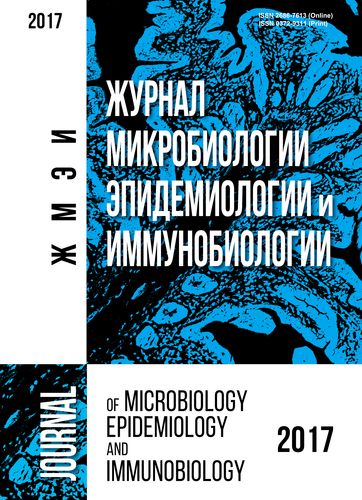ЭПИДЕМИОЛОГИЧЕСКИЙ АНАЛИЗ СИТУАЦИИ ПО ХОЛЕРЕ НА ТЕРРИТОРИИ АФРИКИ И ПРОБЛЕМЫ ПРОФИЛАКТИКИ
- Авторы: Карнаухов И.Г.1, Челдышова Н.Б.1, Гражданов А.К.1, Крицкий А.А.1, Заднова С.П.1, Кедрова О.В.1, Иванова А.В.1, Топорков В.П.1, Смирнова Н.И.1, Boiro A...2, Boumbali S...2, Boiro M.Y.2, Кутырев В.В.1
-
Учреждения:
- Российский научно-исследовательский противочумный институт «Микроб»
- Исследовательский институт прикладной биологии Гвинеи
- Выпуск: Том 94, № 6 (2017)
- Страницы: 105-113
- Раздел: ОБЗОРЫ
- URL: https://microbiol.crie.ru/jour/article/view/237
- DOI: https://doi.org/10.36233/0372-9311-2017-6-105-113
- ID: 237
Цитировать
Полный текст
Аннотация
Об авторах
И. Г. Карнаухов
Российский научно-исследовательский противочумный институт «Микроб»
Автор, ответственный за переписку.
Email: noemail@neicon.ru
Россия
Н. Б. Челдышова
Российский научно-исследовательский противочумный институт «Микроб»
Email: noemail@neicon.ru
Россия
А. К. Гражданов
Российский научно-исследовательский противочумный институт «Микроб»
Email: noemail@neicon.ru
Россия
А. А. Крицкий
Российский научно-исследовательский противочумный институт «Микроб»
Email: noemail@neicon.ru
Россия
С. П. Заднова
Российский научно-исследовательский противочумный институт «Микроб»
Email: noemail@neicon.ru
Россия
О. В. Кедрова
Российский научно-исследовательский противочумный институт «Микроб»
Email: noemail@neicon.ru
Россия
А. В. Иванова
Российский научно-исследовательский противочумный институт «Микроб»
Email: noemail@neicon.ru
Россия
В. П. Топорков
Российский научно-исследовательский противочумный институт «Микроб»
Email: noemail@neicon.ru
Россия
Н. И. Смирнова
Российский научно-исследовательский противочумный институт «Микроб»
Email: noemail@neicon.ru
Россия
A. .. Boiro
Исследовательский институт прикладной биологии Гвинеи
Email: noemail@neicon.ru
Россия
S. .. Boumbali
Исследовательский институт прикладной биологии Гвинеи
Email: noemail@neicon.ru
Россия
M. Y. Boiro
Исследовательский институт прикладной биологии Гвинеи
Email: noemail@neicon.ru
Россия
В. В. Кутырев
Российский научно-исследовательский противочумный институт «Микроб»
Email: noemail@neicon.ru
Россия
Список литературы
- Буаро М.И., Константинов O.K., Бумбали С., Ришар Ж., Лама Н.Е. Холера в Гвинее: эпидемиология, меры борьбы и профилактики. Инфекционные болезни. 2016, 14 (1): 24-28.
- Ганин B.C. По тропам эпидемических катастроф. Иркутск, 2011.
- Ликвидация эпидемии Эбола в Гвинейской Республике: опыт работы специализированной противоэпидемической бригады Роспотребнадзора. Под ред. А.Ю. Поповой, В.В. Кутырева. М., Творческий информационно-издательский центр, 2016.
- Марамович А.С., Пинигин А.Ф. Эндемичные очаги холеры в Африке. Журн. микро-биол. 1995, 2 (Прил.): 101-108.
- Москвитина Э.А., Горобец А.В., Прометной В.И. Эпидемиологическое значение миграции населения при холере. Эпидемиология и инфекционные болезни. 2003, 1:15- 19.
- Москвитина Э.А., Мазрухо А.Б., Адаменко О.Л., Кругликов В.Д. Холера в начале XXI века. Прогноз на глобальном уровне. Проблемы особо опасных инфекций. Саратов, 2012, 1 (111): 11-16.
- Онищенко Г.Г., Москвитина Э.А., Кругликов В.Д., Титова С.В., Адаменко О.Л., Водопьянов А.С., Водопьянов С.О. Эпидемиологический надзор за холерой в России в период седьмой пандемии. Вестник РАМН. 2015, 2: 249-256.
- Смирнова Н.И., Горяев А.А., Кутырев В.В. Эволюция генома возбудителя холеры в современный период. Мол. генет. микробиол. вирусол. 2010, 4: 11-19.
- Холера в СССР в период VII пандемии. Под ред. В.И.Покровского. М., 2000.
- Adewale А.К., Pazhani G.P., Abiodun I.В. et al. Unique clones of Vibrio cholerae 01 El Tor with haitian type ctxB allele implicated in the recent cholera epidemics from Nigeria, Africa. PLoS ONE. 2016, 11 (8): e0159794.
- Dalsgaard A., Forslund A., Sandvang D. et al. Vibrio cholerae 01 outbreak isolates in Mozambique and South Africa in 1998 are multiple-drug resistant, contain the SXT element and the aad2 gene located on class 1 integrons. J. Antimicrob. Chemother. 2001, 48: 827-838.
- Faruque S.М., Nair G.B. Vibrio cholerae genomics and molecular biology. Caister Academic Press, Norfolk, UK. 2008.
- Echenberg M.J. Africa in the time of cholera. New York, Cambridge University Press, 2011.
- Emch М., Feldacker C., Islam M.S. et al. Seasonality of cholera from 1974 to 2005: areview of global patterns. Int. J. Health. Geogr. 2008, 20 (7): 31.
- Harris J.B, LaRocque R.C., Chowdhury F. et al. Susceptibility to Vibrio cholerae infection in a cohort of household contacts of patients with cholera in Bangladesh. PLoS Negl. Trop. Dis. 2008, 2(4): e221.
- Ismail H., Smith A.M., TauN.P. etal. Cholera outbreak in South Africa, 2008-2009: Laboratory analysis of Vibrio cholerae 01 strains. JID. 2013, 208: 39-45.
- Kaas R.S., Ngandjio A., Nzouankeu A. et al. The Lake Chad basin, an isolated and persistent reservoir of Vibrio cholerae 01: a genomic insight into the outbreak in Cameroon, 2010. PLoS One. 2016, 11 (5): e0155691.
- Langa J.P., Sema C., Deus N.D. et al. Epidemic waves of cholera in the last two decades in Mozambique. J. Infect. Dev. Ctries. 2015, 9 (6): 635-641.
- Lan R., Reeves P.R. Pandemic spread of cholera: genetic diversity and relation-ships within the seventh pandemic clone of Vibrio cholerae determined by amplified fragment length polymorphism. Clin. Microbiol. J. 2002, 40 (1): 172-181.
- Nair G. Cholera outbreaks. Cur Top. Microbiol. Immunol. 2014, 379: 1-259.
- Nkoko D.B., Giraudoux P., Plisnier P-D. et al. Dynamics of cholera outbreaks in Great Lakes region of Africa, 1978-2008. Emerg. Infect. Dis. 2011, 17 (11): 2026-2034.
- Opintan J.A., Newman M.J., Nsiah-Poodoh O.A. et al. Vibrio cholerae 01 from Accra, Ghana carrying a class 2 integron and the SXT element. J. Antimicrob. Chemother. 2008, 62: 929-933.
- Pugliese N., Maimone F., Scrascia M. et al. SXT-related integrating conjugative element and IncC plasmids in Vibrio cholerae 01 strains in Eastern in Eastern Africa. J. Antimicrob. Chemother. 2009, 63: 438-442.
- Rebaudet S., Sudre B., Faucher B. et al. Environmental determinants of cholera outbreaks in inland Africa: a systematic review of its main transmission foci and propagation routes. J. Infect. Dis. 2013, 1 (208): 46-54.
- Rebaudet S., Mengel M.A., Koivogui L. et al. Deciphering the Origin of the 2012 cholera epidemic in Guinea by integrating epidemiological and molecular analyses. PLoS. Negl. Trop. Dis. 2014,8(6): 1-10.
- Scrascia М., Pugliese N., Maimone F. et al.Cholera in Ethiopia in the 1990s: epidemiologic patterns, clonal analysis, and antimicrobial resistance. Int. J. Med, Microbiol. 2009, 299 (5): 367-372.
- Swerdlow D.L., Isaacson M. Epidemiology of cholera in Africa. In: I.R. Wachsmuth, P.A. Blake, O. Olsvik (ed.). Vibrio cholerae and cholera: molecular to global perspectives. ASM Press, Washington, D.C., 1994, p. 297-307.
- Тггегир S.L., Ortiz R.A., Markandya A. The costs of climate change: a study of cholera in Tanzania. Int. J. Environ. Res. Public. Health. 2011, 8 (12): 4386-4405.
- WHO report on global surveillance of epidemic-prone infectious diseases. WHO/CDS/CSR/ ISR/2000/1. http://www.who.int/csr/resources/publications/surveillance/WHO_CDS_CSR_ ISR_2000J/en/.
Дополнительные файлы






